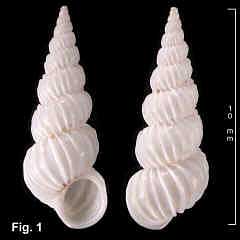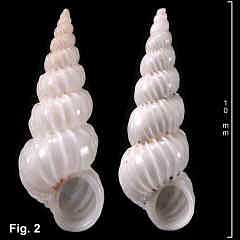|
|
|
|
|
Epitonium jukesianum (Forbes, 1852) Description: Shell slender for genus, variable in height to width ratio; whorls connected. Whorls rounded, with 9-28 axial ribs per whorl, usually continuous from whorl to whorl. Ribs thick or thin, often rolled back on top, not peaked. Interspaces smooth. Aperture oval; outer lip with normal rib externally. Umbilicus closed. Colour white. Operculum corneous. Size: Up to 24 mm in length, usually less than 15 mm. Distribution: Australia and New Zealand. In Australia, at least from northern NSW southwards, around southern Australia to southwestern WA, including Tasmania. The range may be larger, but the boundaries are not known because of the difficulty in distinguishing species at the limits. Habitat: Lives buried in sand, associated with sea anemones. Mainly known from empty shells washed up on beaches. Usually uncommon, but occasionally very common. Comparison: This is by far the commonest of all the epitoniids found in shell grit on NSW beaches. With its tall, slender form it resembles E. tacitum and E.minorum, but is smaller and the whorls are connected. See also "Identification of the NSW species of Epitonium" in the introduction to this family. Synonymy: Synonyms are Scalaria delicatula Crosse & Fischer, 1864; Scalaria wellingtonensis Kirk, 1880; Acutiscala ampacta Iredale, 1936; Acutscala fabia Iredale, 1936. Verco (1906b) reported that he had examined the types of Scalaria delicatula Crosse & Fischer, 1864 in the British Museum, and considered it a synonym of this species. Wilson (1993, p. 276) illustrated a large specimen of E. jukesianum as Epitonium delicatula, but I can see no reason for separating the large specimens as a different species, or for using the name E. delicatula for them. Remarks: This species is variable in height to width ratio and in the number of ribs per whorl. This variability is demonstrated in Fig. 2, which shows two specimens from the same lot from Gunnamatta Bay. The egg masses of this species were described by Smith, Black & Shepherd (1989). "The egg mass consists of 50-200 small, spherical capsules encrusted with sand grains joined together by a fine spring-like thread forming a tangle. Each capsule is between 0.6-0.8 mm in diameter. Hatching takes place about 8 days after laying through a break in the capsule membrane through which the veligers emerge". Fig. 1: Gunnamatta Bay, NSW (C.335907) Fig. 2: Gunnamatta Bay, NSW (C.335907)
|

